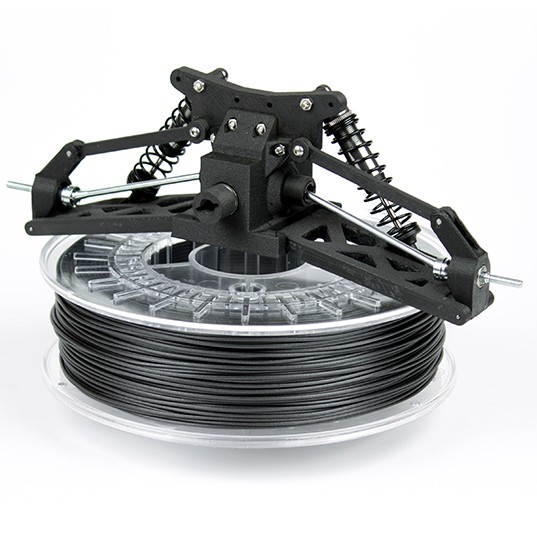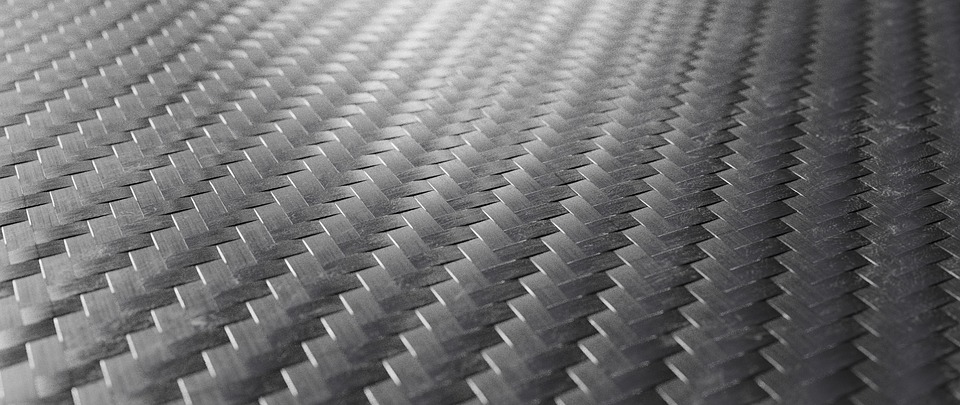Sturdy Carbon Fiber Filament: Properties, How to Use, and Best Brands
In the debate of using PLA or ABS, the answer usually depends on the print being made. One of the most common considerations is the sturdiness of the final print. Although ABS prints are sturdier, they can also be quite brittle and don’t handle much stress before breaking. PLA, being more flexible, yields to stress and can absorb quite a bit before its breaking point. However, there is one material that reigns supreme in the contest of rigidity: carbon fiber filaments.
In this article, we tackle what exactly carbon fiber filaments are, the different types available, how you can use them in 3D printing, and the best brands that are currently available.
What is carbon fiber filament?
Carbon fiber filaments actually refer to a class of filaments made from different base materials that have tiny carbon fibers infused in them. The base material could be any of the most common filament materials used today: PLA, ABS, PETG, Nylon, and more. Carbon fibers serve to increase the durability of the product printed from the filament in terms of stiffness and tensile strength.
Carbon fibers are thin (about 5 to 10 micrometers diameter) fibers composed of carbon atoms bonded together in a crystalline formation. Layers of these carbon atoms are haphazardly crumpled together, creating bonds and lending a very high tensile strength to the product. The crystal alignment gives the fiber an excellent strength-to-volume ratio, allowing carbon fiber to be woven into a variety of applications.
Carbon fiber is one of the most widely used additives for the strength reinforcement of composite materials. This is especially true for applications where weight is a critical consideration, as carbon fiber has a very high strength-to-weight ratio. Carbon fiber reinforced polymers have been widely used in the aerospace (wing spars, airplane hulls), automotive (wheels, chassis) , and sporting goods (tennis racquets, bicycle frames) industry.
What are the benefits of using carbon fiber?
The main strengths of carbon fiber lie in its excellent strength-to-volume ratio and very high strength-to-weight ratio. Thus, it gives excellent rigidity and durability to materials while being much lighter compared to more traditional durable materials such as wood, steel, or aluminum. It also exhibits very good resistance against corrosion and chemical degradation. Unlike steel, it does not have a high tendency to expand or contract according to changes in temperature. Carbon fibers have the capacity to conduct very little amounts of current, which can be useful in specific applications.
Its excellent strength and lightweight properties also translate to advantages in using carbon fiber filaments in 3D printing. The strength of the carbon fibers provides better dimensional stability to the filament, reducing chances of warping or shrinkage. The presence of infused carbon fiber does not significantly affect the properties of the base filament material, so the printer settings that work with your base material should work beautifully with its carbon fiber-infused equivalent.
How do you work with carbon fiber filament?
In working with carbon fiber filaments, keep in mind that the printer settings will vary based on your base material. If you are printing with carbon-fiber infused ABS, then you can use the optimal settings for ABS. This also applies for heated bed temperature settings, adhesion, printing speed, and cooling fan settings. For help in getting the best printer settings, you may consult any of the filament guides that we have published in our site.
Another thing to remember when printing with carbon fiber filaments is that the carbon fibers infused into the filament are quite hard and can wear down on the nozzle of the heated end after repeated use. Brass nozzles, which can be found in most 3D printers today, are soft and especially vulnerable to wearing down by carbon fiber. A worn down nozzle will drastically change how molten filament flows to the print bed, resulting in prints that have very poor quality.
To make sure that your nozzles are maintained in good shape, we recommend using a nozzle made of 100% heat-treated steel when printing with carbon fiber filaments. They are durable enough to withstand the abrasive properties of carbon fiber, but are also known to be less thermally conductive than brass. This means that you may have to set your printing temperature to about 20 to 40 °C higher than usual to prevent clogging at the extruder due to cooling down of the filament.
Keep in mind that the carbon fiber infused into the filament does not melt along with the base plastic material. This presents another challenge in using carbon fiber filaments, as the fibers can easily clog the extruder nozzle especially during retractions. We recommend disabling retractions completely when using carbon fiber filaments. If it cannot be helped, then we recommend using a design that minimizes retraction distances.
Some users have reported better results when using nozzles with larger bores, which reduces the changes of clog formation. Nozzles with 0.6mm to 0.8mm bores are recommended, although 0.4mm to 0.5mm bores can be used with a little difficulty.
Printing at a low speed also puts less stress on the extruder, reducing the chances of clogging in the nozzle. We recommend printing at a speed that is 50% less than the regular printing speed for your material of your choice, then working your way up to see what works best. At best, around a 25% printing speed reduction is still the recommended setting.
What are the drawbacks in using carbon fiber?
As mentioned, carbon fiber filaments can be unusually abrasive, leading to wearing down of the extruder components. You may have to play around with the parts and settings of your extruder to get the best results out of using carbon fiber filaments. In addition to wear and tear on the extruder, common extruder-related problems include:
- The carbon fiber filament being too hard for the idler and gear pinch assembly to convey, resulting in slow delivery to the hot end
- Clogging of the carbon fiber in the hot end nozzle
- Snapping of the carbon fiber filament within the extruder assembly
A drawback of the extremely rigid characteristic of carbon fiber filaments is that they can be too brittle to negotiate tight corners in the filament path of some extruders. It will help to ensure that the filament path, from the spool to the nozzle, consists only of gentle curves where the filament will not tend to break.
Lastly, one of the other drawbacks of using carbon fiber filament is that you literally pay for the durability that it provides to your print. Compared to a comparable spool of standard PLA or ABS, their carbon fiber-infused counterparts are generally much more expensive. That being said, carbon fiber filaments satisfy very particular requirements for 3D prints.
What are the best brands of carbon fiber available right now?
There is a surprisingly large selection of carbon fiber filament products available today, with most manufacturers releasing several variations made from different base materials.

The XT-CF20 product line from ColorFabb is far and away the most popular carbon fiber filament products in the market. It is a PETG-based filament infused with 20% carbon fiber. The high melt property of PETG makes prints made from the XT-CF20 extra sturdy, and with great dimensional accuracy. Prints made from XT-CF20 end up with a matte black finish, making for a very visually interesting product. The XT-CF20 carbon fiber filament is available in a 1.75mm size, and sold in 0.75kg spools.

The ZIRO Carbon Fiber Filament uses a PLA base, resulting in a mixture of 70% PLA and 30% carbon fiber. The filament prints at slightly lower temperatures, but will require a large-bore nozzle to avoid clogs. However, the durability and sturdiness of prints made from the ZIRO Carbon Fiber Filament are still unquestionable. ZIRO sells their Carbon Fiber Filament in 1.75mm size and in 0.8kg spools.

YOYI sells a similar a PLA-based carbon fiber filament that can be printed at 200 °C and can make high durability prints that are wear-resistant and have a good, crisp finish. This is a relatively cheaper option, which is perfect if you’re only just trying out printing with carbon fiber filaments. YOYI sells their 1.75mm carbon fiber filaments in either 0.8kg or 1kg spools.

Proto-pasta has a veritable line of PLA-based carbon fiber filament products, each one designed to serve a specific need. The CFP11705 carbon fiber filament has the unique honor of being the original PLA-based carbon fiber filament. Since its development, the CFP11705 has become much more affordable while still retaining its excellent physical properties.
The HTP21705-CF and the HTP22805-CF are both carbon fiber filaments from Proto-pasta that were made to be printed at higher temperatures. This definitely makes the printing process easier and smoother, and results in stronger prints. All the carbon fiber filament products from Proto-pasta are sold in 500g spools, and are available in 1.75mm and 2.85mm sizes.
The Roundup
| Material | Carbon fiber filament |
| Applications | – Wing spars – Automotive wheels – Car chassis – Tennis and badminton racquets – Bicycle frames |
| Properties | – Very strong – Lightweight – Good resistance against corrosion – Chemical-resistant |
| Recommended printing temperature | 20 to 40 °C higher than the printing temperature of the base material, especially when using a steel extruder nozzle |
| Recommended bed temperature | Heated bed is optional but a heated bed at 45 to 60 °C will be optimal |
| Printing speed | Start at 50% slower than standard printing speed of base material, then work your way up |
| Adhesion | Depends on base material |
| Cooling | No cooling fan |
| Other accessories needed | Hardened steel extruder nozzle |
Carbon fiber filaments are one of the most favorite materials that adventurous 3D printing hobbyists work with. The superior durability and interesting matte black finish of prints made from carbon fiber filament are truly unique attributes. Carbon fiber filaments are not the easiest material to work with, and you may have to tweak your 3D printers a little to get good results, but the products have the potential to be very useful. With a wide variety of carbon fiber filament products available in the market, you should be able to find one that works for you and your printer model.




Great post. Thank you very much.